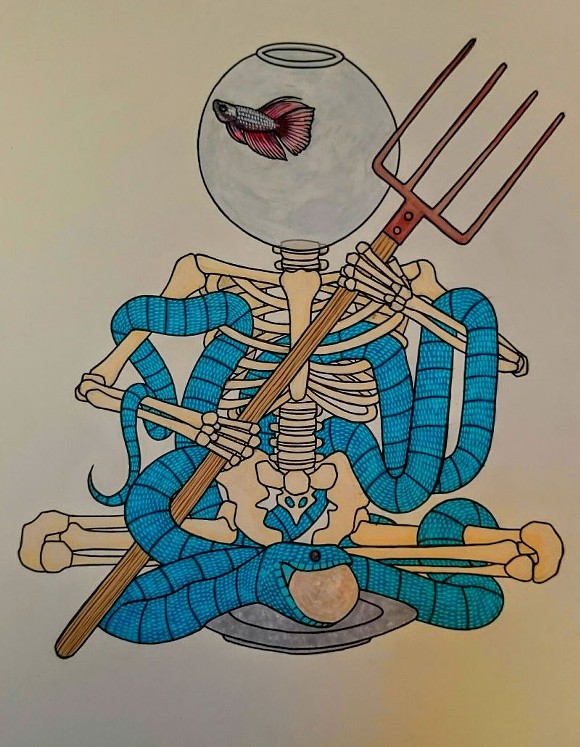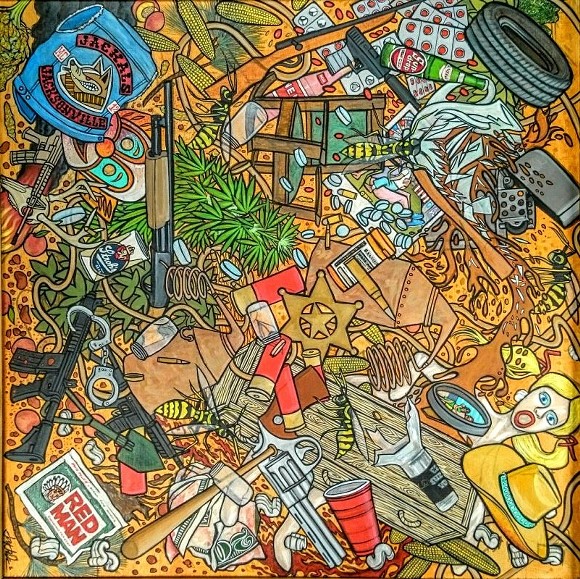JAY JACOBS is clearly a fan of the metaphor.
“[My art] is like hieroglyphs. You can tell what certain things probably mean,” he explains. “It’s like soup. A good soup, you don’t realize how many things go in it.”
In “No Place to Rest,” open now at the Butcher, the Augusta artist piles meaning after meaning onto each piece he creates.
“I’m using a lot of symbolism and a lot of visual totems to reflect things,” explains Jacobs. “A lot of them are personal, but that’s never really explained. Everything’s left intentionally ambiguous. I love the idea of three people looking at the painting and all of them coming up with different stories.”
For instance, he uses the snake in many of the pieces as a deliberate metaphor for self-doubt.
“I wrestle with that—I’m self-taught so I have a chip on my shoulder,” he explains. “I’m always scared someone’s gonna figure out I don’t know what I’m doing.”
Jacobs represents himself in the paintings with a blue jay, an allusion to his own name. The jay and the snake interact often throughout the series.
“They both need each other,” he muses. “But one of the paintings I’ve got a blue jay with wormswood in his beak, which is a snake deterrent.”
“I’ve done one one time where I used snakes through the ten paintings to represent wisdom,” he continues, “because in a lot of old folklore and the Bible and things like that, the snake depicts wisdom and the tree of knowledge, all that. I use an elephant to represent memory, the idea of what we learn versus what we understand and what we remember and how we apply our memories to what we actually know is real. So, I’ve got a snake choking an elephant.”
However, don’t dig too deeply for meaning in every single piece. “Sometimes a snake is just a snake,” he advises.
The varying depth of Jacobs’ work is what keeps the collection fresh and intriguing—and what demands attention from the viewer.
“At this point, in the way that I work, it’s an odd kind of formula,” he says, “but one that just came out of necessity. When I work, I work in about three to four different styles at the same time. It’s a catharsis because if I’m working very meticulously on one thing, then I’m apeshit crazy on the other one.
“I like the idea that things don’t have one meaning, so if you say, ‘Oh well, that elephant means memory,’ then you’re amputating the potential meaning because if you rest on that definition, you can’t go anywhere.”
Jacobs uses acrylic painting on panel in a style that ends up looking like an illustration thanks to its tightness. The biggest departure from that style is an untitled piece of two girls standing in front of a fire. The loose brush strokes and featureless faces leave the ambiguity that Jacobs loves.
The most visually captivating piece is the only titled one, “Bull Mountain,” based on a book with the same name by Augusta author Brian Panowich. Layers upon layers of small details, from a sheriff’s badge to a broken liquor bottle to scattered prescription pills, fill the painting, which ends up feeling almost like a hidden picture puzzle. There’s so much going on in the piece that it feels overwhelming—just the way Jacobs likes it.
“I tend to overwork things, hence the [name] ‘No Place to Rest,” he explains. “It’s a multifaceted meaning to that. One, things are extremely busy so it’s a lot of dense imagery. You’re not gonna get it in a peripheral view. You have to pay attention to recognize what’s happening because there’s a lot of shit going on.”



